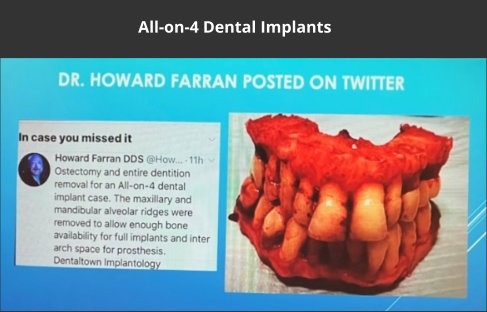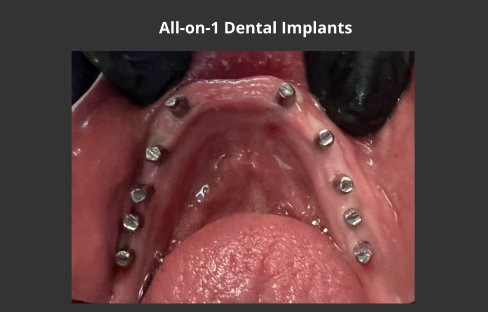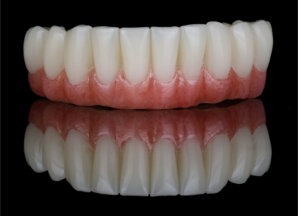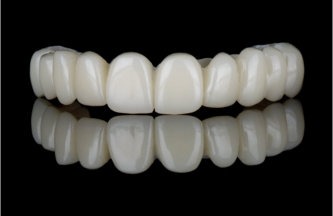
Mono Implant Academy
Welcome!
Elevate your dental practice with Mono Dental Implants and get instant answers anytime with Jenny, our AI Voice assistant.
All-on-4™ vs All-on-1™ Dental Implants: Enhancing Quality of Life with Proper Care and New Teeth
Discover the benefits of All-on-1 vs All-on-4 dental implants at Mono Implant Academy, including improved oral hygiene, prevention of bone loss, and tailored treatment plans for tooth loss. Get a free consultation to enhance your quality of life with replacement teeth today!
This chart is designed to provide a side-by-side comparison between the two systems so you can easily see how they differ from one another.
This chart is designed to provide a side-by-side comparison between the two systems so you can easily see how they differ from one another.


Surgery
It is a very aggressive surgery where the dentist removes gum tissue and part of the jawbone to make way for the prothesis.
It is a very aggressive surgery where the dentist removes gum tissue and part of the jawbone to make way for the prothesis.
Surgery
It requires minimal surgery, just enough to start a small implant and doesn't require removing part of your jawbone to make room for the prothesis. The above picture was taken within 90 minutes of the procedure.
It requires minimal surgery, just enough to start a small implant and doesn't require removing part of your jawbone to make room for the prothesis. The above picture was taken within 90 minutes of the procedure.
Bone Grafts
Bone grafts are not required as they typically are with traditional implants, as the patient must have adequate bone density and structure to qualify for the procedure.
Bone grafts are not required as they typically are with traditional implants, as the patient must have adequate bone density and structure to qualify for the procedure.
Bone Grafts
No bone grafts are required. Since mono implants can be placed in different areas of the jaw where traditional implants can't be placed, more patients can qualify for this procedure.
No bone grafts are required. Since mono implants can be placed in different areas of the jaw where traditional implants can't be placed, more patients can qualify for this procedure.
Pain
The surgery is aggressive but with proper numbing procedures you shouldn't feel the pain during the surgery. The pain afterwards is controlled generally by over-the-counter medications.
The surgery is aggressive but with proper numbing procedures you shouldn't feel the pain during the surgery. The pain afterwards is controlled generally by over-the-counter medications.
Pain
Minimal pain that is controlled with over-the-counter medications and generally is resolved in a couple of days.
Minimal pain that is controlled with over-the-counter medications and generally is resolved in a couple of days.

Prothesis
FP3 prothesis which is both fake gum and zirconium teeth to make up for the amount of bone and gum tissue that was removed.
FP3 prothesis which is both fake gum and zirconium teeth to make up for the amount of bone and gum tissue that was removed.

Prothesis
FP1 teeth only zirconium prothesis. This it the ultimate full arch implant prothesis that the dental implant community has been trying to achieve for decades.
FP1 teeth only zirconium prothesis. This it the ultimate full arch implant prothesis that the dental implant community has been trying to achieve for decades.
Difficulty of Procedure
The normal time required for the procedure is 6-8 hours and includes 4 traditional implants to support each arch.
The normal time required for the procedure is 6-8 hours and includes 4 traditional implants to support each arch.
Difficulty of Procedure
The normal time required is 3.5 to 4 hours and includes 8-12 mono implants to support each arch.
The normal time required is 3.5 to 4 hours and includes 8-12 mono implants to support each arch.
Difficulty to Learn
It costs thousands of dollars, and many weekends to learn how to do All-on-4™ implants, where you have to sacrifice your family time to learn this process.
It costs thousands of dollars, and many weekends to learn how to do All-on-4™ implants, where you have to sacrifice your family time to learn this process.
Difficulty to Learn
At our one two-day seminar you will learn how to do the All-on-1™ mono implant system because of the ease of doing mono implants. The time away from your family is one weekend.
At our one two-day seminar you will learn how to do the All-on-1™ mono implant system because of the ease of doing mono implants. The time away from your family is one weekend.
Price
The price is dependent on geographic area, but a full mouth reconstruction will typically run $55,000 - $70,000.
The price is dependent on geographic area, but a full mouth reconstruction will typically run $55,000 - $70,000.
Price
The price is $49,800 for a full mouth reconstruction with a profit margin of 90% or better.
The price is $49,800 for a full mouth reconstruction with a profit margin of 90% or better.
All-on-4™ verses All-on-1™
A major advantage of All-on-1™ mono implants is that they are more stable than All-on-4™ implants. With All-on-4™ implants, the angulation of the implants can create pressure points, which can lead to fractures in the implant or the cantilevered full arch prostheses. All-on-1™ mono implants offer a more stable solution since 8 to 12 implants are placed, which provides more support to the full ache prosthesis.
Learn About Our January 2025 Seminar
What Are All-on-4 Dental Implants?
All-on-4 dental implants are a modern solution for those with significant tooth loss. This technology involves placing four titanium posts in the upper or lower jaw as artificial tooth roots. These posts support a full set of artificial teeth, creating a natural look and permanent fix for missing teeth.
This method efficiently solves the problem of missing teeth, often skipping the need for bone grafting. With All-on-4 implants, patients can regain a confident smile and better oral function, enhancing their quality of life. It benefits those who have lost many teeth due to gum disease, injury, or other causes.
This method efficiently solves the problem of missing teeth, often skipping the need for bone grafting. With All-on-4 implants, patients can regain a confident smile and better oral function, enhancing their quality of life. It benefits those who have lost many teeth due to gum disease, injury, or other causes.
How Do All-on-4 Implants Differ from All-on-1 Dental Implants?
Both all-on-4 dental implants and all-on-1 dental implants are solutions for replacing missing teeth, but they differ significantly in their approach and application.
All-on-4 Implants: All-on-4 implants involve placing four dental implants into the jawbone to support a full arch of teeth. This method is designed for patients who have lost most or all of their teeth and want a long-term solution. The implants are strategically placed to maximize bone use, often allowing for immediate placement of a temporary set of teeth.
All-on-1 Implants: While less commonly referred to by this specific term, All-on-1 implants typically refer to everything from a single implant supporting one prosthetic tooth to a full arch prothesis. This is ideal for individuals who are missing all their teeth or just a single tooth and want a permanent replacement that mimics the look and function of a natural tooth.
The critical difference lies in the scope: All-on-4 is used for replacing a complete set of teeth using four implants, while All-on-1 addresses replacing a single tooth with one implant or a full arch with 8 - 12 implants.
All-on-4 Implants: All-on-4 implants involve placing four dental implants into the jawbone to support a full arch of teeth. This method is designed for patients who have lost most or all of their teeth and want a long-term solution. The implants are strategically placed to maximize bone use, often allowing for immediate placement of a temporary set of teeth.
All-on-1 Implants: While less commonly referred to by this specific term, All-on-1 implants typically refer to everything from a single implant supporting one prosthetic tooth to a full arch prothesis. This is ideal for individuals who are missing all their teeth or just a single tooth and want a permanent replacement that mimics the look and function of a natural tooth.
The critical difference lies in the scope: All-on-4 is used for replacing a complete set of teeth using four implants, while All-on-1 addresses replacing a single tooth with one implant or a full arch with 8 - 12 implants.
What Is the Procedure for Getting All-on-4 Implants?
The process for getting All-on-4 implants includes several steps:
Initial Consultation: A thorough review of dental health and discussion of treatment options.
Dental Imaging: CT scans assess bone structure and plan implant placement.
Dental Implant Surgery: Placing four titanium posts in the jawbone. These serve as anchors for the new teeth. The surgery required is considered major surgery as it has to shave down the jawbone to make room for the cantilevered prothesis.
Temporary Teeth: Temporary teeth are attached immediately or soon after surgery, allowing patients to leave with functional teeth.
Healing Period: The bone needs a few months to fuse with the posts, ensuring they are stable and strong.
Final Prosthesis: After healing, temporary teeth are replaced with a custom-made permanent set that looks and functions like natural teeth. It is a FP3 protheses, which is plastic gums to make up for the reduction in the jawbone.
This streamlined process shortens overall treatment time and lowers the risk of complications.
Initial Consultation: A thorough review of dental health and discussion of treatment options.
Dental Imaging: CT scans assess bone structure and plan implant placement.
Dental Implant Surgery: Placing four titanium posts in the jawbone. These serve as anchors for the new teeth. The surgery required is considered major surgery as it has to shave down the jawbone to make room for the cantilevered prothesis.
Temporary Teeth: Temporary teeth are attached immediately or soon after surgery, allowing patients to leave with functional teeth.
Healing Period: The bone needs a few months to fuse with the posts, ensuring they are stable and strong.
Final Prosthesis: After healing, temporary teeth are replaced with a custom-made permanent set that looks and functions like natural teeth. It is a FP3 protheses, which is plastic gums to make up for the reduction in the jawbone.
This streamlined process shortens overall treatment time and lowers the risk of complications.
Who Is a Candidate for All-on-4 Dental Implants?
All-on-4 dental implants are suitable for those who:
● Have multiple missing teeth or complete tooth loss.
● Have significant bone loss but enough structure to support implants without grafting.
● Do not have severe gum disease.
● Have a stable facial structure and are in overall good health.
Consulting a dental professional is necessary to confirm suitability for this procedure.
● Have multiple missing teeth or complete tooth loss.
● Have significant bone loss but enough structure to support implants without grafting.
● Do not have severe gum disease.
● Have a stable facial structure and are in overall good health.
Consulting a dental professional is necessary to confirm suitability for this procedure.
How Does All-on-1 Compare to All-on-4 Dental Implants?
There are two main options when choosing dental implants for a full-mouth makeover: all-on-1 mono dental implant system and All-on-4 system. Both aim to restore the look and function of natural teeth, but they differ in how they work. Knowing these differences can help dentists and patients make the best decisions.
All-on-1 Dental Implants:
● Tooth Root Replacement: 8 to 12 mono dental implants per arch are used to replace the tooth roots across the jaw.
● Temporary Teeth: Provides temporary teeth immediately during the healing period.
● Procedure Duration: It takes about 3.5 to 4 hours for full mouth restorations with minimal surgery.
● Placement: This can be done even if bone density is low, reducing the need for bone grafts.
● FP1 Prothesis: This prothesis is only teeth which is the ultimate goal of implantology. This is achieved because there isn’t any bone reduction as is the case with All-on-4.
● Healing Time: Shorter due to less invasive surgery.
● Initial Consultation: Involves a detailed assessment to create a tailored treatment plan.
● Efficiency: A good solution for those needing full-mouth reconstruction.
All-on-4 Dental Implants:
● Tooth Root Replacement: Uses four implants per arch, placed at specific angles.
● Temporary Teeth: Offers immediate temporary teeth that look like the final prosthesis.
● Procedure Duration: Takes around 6-8 hours per arch and involves more intense surgery.
● Placement: Needs enough bone density; bone grafts might be required.
● P3 Prothesis: This prothesis is gum and teeth, because part of the patients jawbone has to be reduced to make room for the cantilevered bridge.
● Healing Time: Longer because of the more aggressive surgical approach.
● Initial Consultation: A comprehensive evaluation is required to plan the treatment.
● Challenges: Fewer implants can create stress points, leading to possible issues.
All-on-1 Dental Implants:
● Tooth Root Replacement: 8 to 12 mono dental implants per arch are used to replace the tooth roots across the jaw.
● Temporary Teeth: Provides temporary teeth immediately during the healing period.
● Procedure Duration: It takes about 3.5 to 4 hours for full mouth restorations with minimal surgery.
● Placement: This can be done even if bone density is low, reducing the need for bone grafts.
● FP1 Prothesis: This prothesis is only teeth which is the ultimate goal of implantology. This is achieved because there isn’t any bone reduction as is the case with All-on-4.
● Healing Time: Shorter due to less invasive surgery.
● Initial Consultation: Involves a detailed assessment to create a tailored treatment plan.
● Efficiency: A good solution for those needing full-mouth reconstruction.
All-on-4 Dental Implants:
● Tooth Root Replacement: Uses four implants per arch, placed at specific angles.
● Temporary Teeth: Offers immediate temporary teeth that look like the final prosthesis.
● Procedure Duration: Takes around 6-8 hours per arch and involves more intense surgery.
● Placement: Needs enough bone density; bone grafts might be required.
● P3 Prothesis: This prothesis is gum and teeth, because part of the patients jawbone has to be reduced to make room for the cantilevered bridge.
● Healing Time: Longer because of the more aggressive surgical approach.
● Initial Consultation: A comprehensive evaluation is required to plan the treatment.
● Challenges: Fewer implants can create stress points, leading to possible issues.
Which Is More Effective for Full Mouth Rehabilitation?
When considering full-mouth rehabilitation, the choice between All-on-1 and All-on-4 dental implants depends on various factors. All-on-1 implants offer stability through 8 to 12 implants supporting each full arch, enhancing oral function by providing improved chewing and speaking abilities with multiple support points. The risk of complications is generally lower as stress spreads across more implants, making it a suitable option for full mouth restorations.
On the other hand, all-on-4 dental implants are highly effective and have a high success rate, provided there is enough bone density. While they also improve oral function, they may be less stable compared to All-on-1 due to the 4 implants involved per arch. Consequently, there's a relatively higher risk of complications due to the pressure exerted on fewer implants.
On the other hand, all-on-4 dental implants are highly effective and have a high success rate, provided there is enough bone density. While they also improve oral function, they may be less stable compared to All-on-1 due to the 4 implants involved per arch. Consequently, there's a relatively higher risk of complications due to the pressure exerted on fewer implants.
What Are the Pros and Cons of Each Option?
All-on-1 Dental Implants:
Pros:
● Less invasive with shorter treatment times.
● Strong and stable with multiple implants.
● Reduced need for bone grafting.
● Faster recovery.
● FP1 prothesis
● Cost less even though there are more implants used.
Cons:
● Primarily available through specialized providers like Mono Implant Academy.
All-on-4 Dental Implants:
Pros:
● Well-known and widely practiced.
● More dentists to be familiar with the technique.
Cons:
● More invasive surgery with longer healing times.
● Jawbone reduction
● Higher chance of complications due to stress on fewer implants.
● Bone grafting might be needed for some patients.
● More time is required to place the implants, usually 8-9 hours
● FP3 Prothesis which is not as aesthetically pleasing as a FP1 prothesis
Pros:
● Less invasive with shorter treatment times.
● Strong and stable with multiple implants.
● Reduced need for bone grafting.
● Faster recovery.
● FP1 prothesis
● Cost less even though there are more implants used.
Cons:
● Primarily available through specialized providers like Mono Implant Academy.
All-on-4 Dental Implants:
Pros:
● Well-known and widely practiced.
● More dentists to be familiar with the technique.
Cons:
● More invasive surgery with longer healing times.
● Jawbone reduction
● Higher chance of complications due to stress on fewer implants.
● Bone grafting might be needed for some patients.
● More time is required to place the implants, usually 8-9 hours
● FP3 Prothesis which is not as aesthetically pleasing as a FP1 prothesis
How Long Does the Treatment Process Take for Each?
When considering dental implants for a full-mouth makeover, you have two main options: All-on-1 and All-on-4 systems. These systems aim to restore natural teeth' appearance and functionality, but they differ significantly in their approach and treatment process.
1. All-on-1 Dental Implants: The initial step involves a comprehensive consultation where a personalized treatment plan is crafted. This may include a free consultation to assess patient needs without charge. The procedure typically takes about 3.5 to 4 hours for a full mouth restoration, with faster healing times due to its less invasive nature. Additionally, fewer risks and complications lead to a smoother recovery process.
2. All-on-4 Dental Implants: The process begins with a detailed consultation to determine suitability and plan the procedure accordingly. This involves a thorough examination and planning phase. The procedure takes 8 – 10 hours for a full mouth restoration, with a longer healing period due to its more intense surgical approach. However, there may be a higher risk of complications, affecting overall recovery time.
Contact Mono Implant Academy for more information and a personalized consultation tailored to your needs. Our expert team specializes in cutting-edge dental solutions and is dedicated to helping you achieve optimal oral health and function. Contact us today to explore the best implant option for you.
1. All-on-1 Dental Implants: The initial step involves a comprehensive consultation where a personalized treatment plan is crafted. This may include a free consultation to assess patient needs without charge. The procedure typically takes about 3.5 to 4 hours for a full mouth restoration, with faster healing times due to its less invasive nature. Additionally, fewer risks and complications lead to a smoother recovery process.
2. All-on-4 Dental Implants: The process begins with a detailed consultation to determine suitability and plan the procedure accordingly. This involves a thorough examination and planning phase. The procedure takes 8 – 10 hours for a full mouth restoration, with a longer healing period due to its more intense surgical approach. However, there may be a higher risk of complications, affecting overall recovery time.
Contact Mono Implant Academy for more information and a personalized consultation tailored to your needs. Our expert team specializes in cutting-edge dental solutions and is dedicated to helping you achieve optimal oral health and function. Contact us today to explore the best implant option for you.
